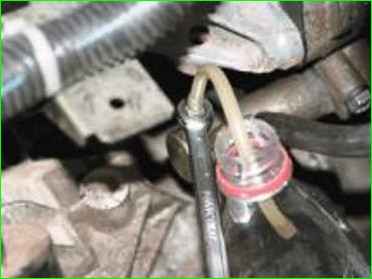If the clutch does not disengage completely when the pedal is pressed all the way ("leads"), which is accompanied by a characteristic grinding of gears when reverse gear is engaged, there may be air in the clutch hydraulic drive.
Remove it by bleeding the drive.
In addition, bleeding is performed when filling the hydraulic drive with fluid after replacing it or after repairing system components associated with its depressurization.
You will need: an "8" wrench, a bleeding hose, a container for brake fluid, brake fluid.
Carry out the work with an assistant on an inspection ditch.
- 1. Pour (or top up) fluid into the reservoir to the lower edge of the filler neck.
- 2. Attach a bleeder hose to the slave cylinder valve.
Lower the other end of the hose into a container with a small amount of brake fluid so that it is submerged in the fluid.
3. Press the clutch pedal 4-5 times and hold the clutch pedal pressed.
Have the assistant press the pedal sharply, with intervals of 2-3 seconds between presses.
4. Open the bleeder valve to release air from the system. Liquid with air bubbles will come out of the hose into the container.

- 5. After the liquid stops flowing out of the hose, tighten the nipple, release the clutch pedal.
- 6. Repeat steps 4, 5 and 6 several times until fluid starts to come out of the hose without air bubbles.
Do not allow the fluid level in the reservoir to fall below the "min" mark.
Add fluid in a timely manner, otherwise, when the bottom of the reservoir dries, air will get into the system and bleeding will have to be repeated again.
- 7. Remove the hose from the bleeding valve and put on the cap.
- 8. Add brake fluid to the master cylinder reservoir to the "max" mark.
Check the clutch operation.





